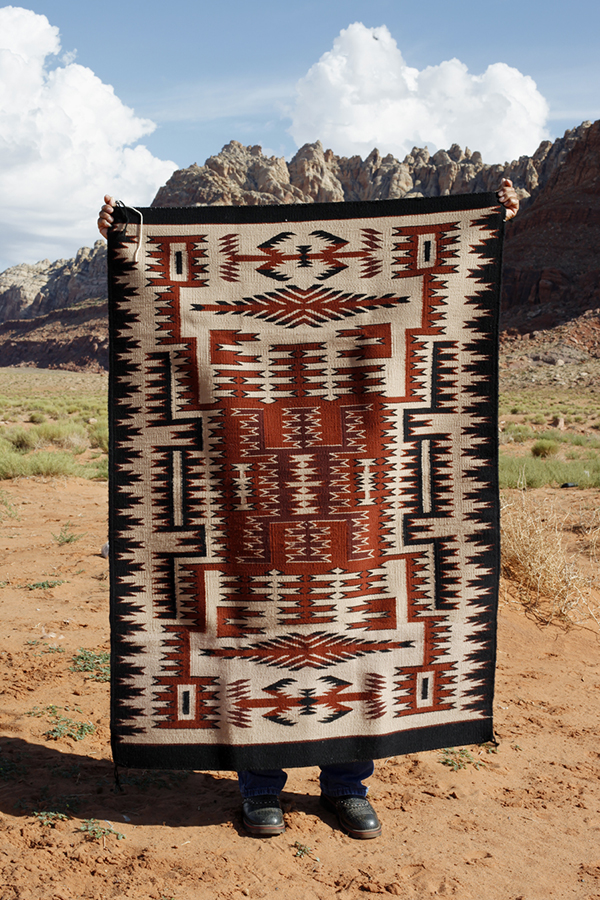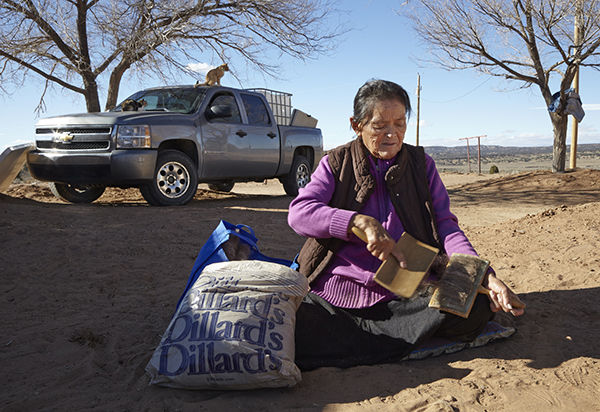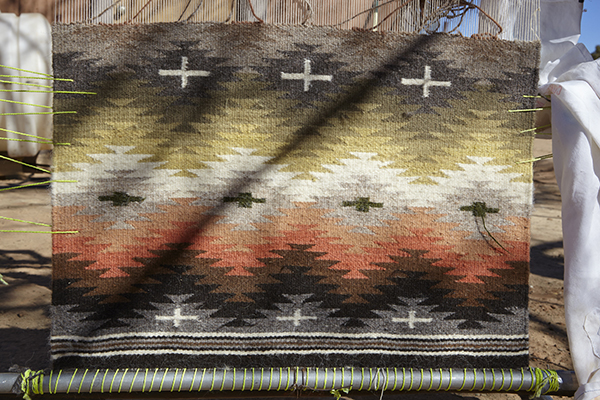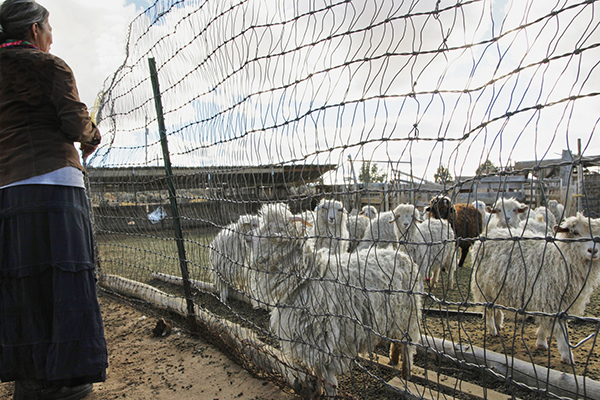

During my visits, I made some photographs, held interesting conversations and conducted short interviews. In my notes, I listed some of the things that are most important to them: Family, Unity, Support, Connection, Integrity, Humor, Contemplation, Vision. I’m sure there is much more. I also list several questions that I wanted to ask them, including; What is the personal and cultural satisfaction of having the Churro, the traditional sheep? What customs do you want to hand down to subsequent generations? And, most importantly to me – What can modern culture learn from the Navajo/Native way of life? Although I didn’t receive succinct answers to these questions, I did gain new insights based on my contact with these amazing people. I was left with the distinct feeling that there is something the Diné know about life that is lost in modernity. Here are a few excerpts from my notes of that time period.

Gloria Displaying Her Mother's Last Rug, © Emily Matyas
I believe I am at Gloria’s. Waiting. Many beautiful full clouds. Some darkness off to the west. Three horses just came up – loose – to drink from the trough. Metal barrel, cut-off/open. They regard me from time to time. It looks like it may rain.
An elderly man just came out on a hobbled run with his cane, to chase the horses off because one was scratching its neck on the wire that holds up the electrical post. I asked him about Gloria’s whereabouts – he agreed that she went to Page but would be back. Here, I am a stranger.
3:08 p.m. A small herd of goats – seven -- and one black-faced sheep has just trooped past my car. A few eyed me surreptitiously where I sit with the car door open. All have horns, two with very long ones curved like a “y” and with little goatee beards. They are grazing now on ground cover greens and maybe garbage. The flies are coming in my open windows and doors. But it’s too hot to shut them. I hear thunder in the distance.

Evelyn Carding Wool, © Emily Matyas
(Notes from a conversation with Maggie)
The Churro is the indigenous breed of sheep in the area, used by the Diné until the 1930s. The U.S. government killed the sheep by shotgun, to bring in Merino sheep whose wool works better in the U.S. wool gins and therefore, the broader economy. But the Churro have many advantages over the Merino. They are adapted for the climate in the Four Corners area and its rocky slopes, much like the Big Horn Sheep. Plus, the Churro wool is much denser and twice as warm as Merino. It can be woven so densely that you could make a watertight vessel with it. It is not as soft, however, and therefore, perhaps not as marketable by Anglo standards.
Lorraine and Edith’s grandmother, Alice, witnessed the slaughter of the Churro sheep in the 1930s. Fortunately, in her lifetime, she was also able to experience the re-entry of the sacred sheep in the 1970s. She enjoyed herding them once again, as her grandchildren do now.
(Notes from the Squaw Dance Ceremony)
Today I greeted people, stood or sat idly by, made fry bread with Ernie and Gloria, and helped cut up fruit. I photographed the sheep, which were corralled in a pen, waiting to be slaughtered. Later some kids came by and climbed in the pen to play, chasing and taunting. They were interested in having their picture taken.
I was introduced to a friend of Gloria’s who lives in Mesa. She said that sometimes she doesn’t know what’s going on at the ceremonies, but that living in the city numbs her.
A teenage boy stood by the Hogan, dressed for the ceremony. His torso was painted black, as was his face, along with some other colors and feather adornments. A woman said to him, “ You can’t play with those boys now, you’re a man.” He asked, “Can I go to school?” She answered, “Yes, but don’t chase girls.” “Then I won’t go to school.” Laughter.
I left at sunset from this gathering in the piñon pine trees. Along the dirt road on the way back, I stopped to photograph a rainstorm in the distance.

© Emily Matyas
(A visit with Gloria at her house)
Gloria was upbeat and brought out her mother’s last rug. We photographed it outside, where she held it up against a backdrop of the Vermilion Cliffs. Then inside, she showed me her loom, made from an old metal bed frame. It held a rug about one third done, in colors of rust, white, black and gray. She pointed out the spider design in it and showed me that her mother’s rug had one too. They looked similar, but with distinct details. She explained that each weaver has a unique style. She also showed me the spirit line on her mother’s rug – a space that was open to the edge. She said that it’s a custom of Navajo weaving, intended to remind weavers to keep their minds open. She also showed me the figure that represents a centipede, and said the word in Diné. I repeated it, but can’t remember it now. Gloria grows, cleans, spins and dyes her own wool, though admits that she sometimes buys it from the store.

© Emily Matyas
(Visit to the home of Lorraine Herder, Edith Simonson and Evelyn Simonson)
Three years ago, Lorraine and Edith’s mother, Alice, passed away at age 102. She was a Churro herder, traveling on foot with the sheep. Shearing was done once a year, in May, with hand scissors. She processed the wool, also by hand, carding, spinning and washing, which the kids learned by the age of eight. When Lorraine was that age, she snuck some of her mom’s yarn and set up her own loom behind the hill. She finished her rug and showed it to her mom, who complimented it, saying it was very uniform. Lorraine started selling rugs when she was a teenager.
Lorraine and Edith’s family always had Churro sheep, even after the kids went off to school. And they’ve always herded them the old way. There is a certain method to it. Instead of following directly behind the sheep, you stay to one side. You must guide them. And because you are out there with the sheep, you also take care of the land, perhaps arranging rocks and twigs to prevent soil erosion. As the herder, you need to be physically fit to do the job.
Lorraine says she dislikes it when the government’s Navajo Diabetes Special Project tells them how to keep in shape or what to eat. “All we have to do is herd our sheep,” she says. “You’re out there for four to five hours with them, walking, and you take only fruit with you to eat. They graze on grass, which is organic, better for them and for us. Also, we eat corn mush made from homegrown blue corn meal, fortified with ashes from cedar. That contributes to the color and the calcium content. My mom led this lifestyle. That’s how she got to be 102.”
The family is self-sufficient and lives off the land, using all parts of the Churro sheep for their livelihood. Nothing is wasted. They don’t buy meat from the store. Lorraine and her husband also harvest melon and squash and have an orchard of peach trees. They make their own compost, a “manure tea.” Lorraine says, “We are some of the few people who actually hand process the wool. We harvest and work with not only the wool, but also the meat, and use the sheepskins to make pelts. People come around to trade for our goods, with corn products, other materials, or whatever they can give -- but not jewelry because the value can’t be known. It might be made of plastic.”
They live on a part of the Reservation that is involved in the land dispute between the Hopis and Navajo. It was partitioned in 1973. The issues seem to be revving up again, so the sisters worry that their sheep may be in peril, like they were in the 1930s. The Bureau of Indian Affairs and the Navajo Nation decide who gets the grazing permits. Also, the Hopi side is where the water is, including the springs and the windmills. Lorraine says, “It’s an unsettling feeling that the government can mess with our lives.”
The sisters are also concerned that the younger generation isn’t picking up the traditions. Edith talks to them, and does all the washing and spinning of the wool in front of the grandkids. If they’re interested, they will learn. There is at least one granddaughter who has picked up the art of weaving. She started with commercial yarn in first grade. When she had completed half her rug, she said, “Grandma, can you finish this for me? And then when you sell it you can give me half the money.”
Weaving itself is not a dying art. According to Lorraine, there are many young weavers, but their works made with store-bought yarn are hard to compete with. The traditional weaver spends weeks or months of time preparing their wool for weaving. A buyer may appreciate the muted tones of a rug woven with natural fibers and dyes, but they are often dazzled by the brilliant colors of rugs made using commercial yarn. Those prices are lower too.
It is important to note that Churro wool sells better on the Reservation and is a source of income for the family. Merino wool has short fibers and isn’t fit for Navajo weaving. Lorraine, Edith and Evelyn often sell their work at festivals or museums such as, the Heard Museum in Phoenix, the Bullock Texas State History Museum in Austin, the Museo de Las Americas in Denver, and the Maxwell Museum of Anthropology in Albuquerque, among others.
In many ways the family adheres to a traditional lifestyle. They continue to weave as their ancestors did, using the natural shades of Churro wool or dyes from the plants in their environment. They still ride horses. They eat home-cooked foods, and sit down together for meals, the upside of living far from a store. Even if the kids go off to school or work, they find time to come home, to gather and to talk to Grandma. “She will be here for us and she will guide us,” says Lorraine. “Our belief,” she says, “is here – the ground, the earth, the plants, the sky – those are the things we worship. Those plants out there are medicine. Sitting in this dirt makes us balanced.”
© Emily Matyas